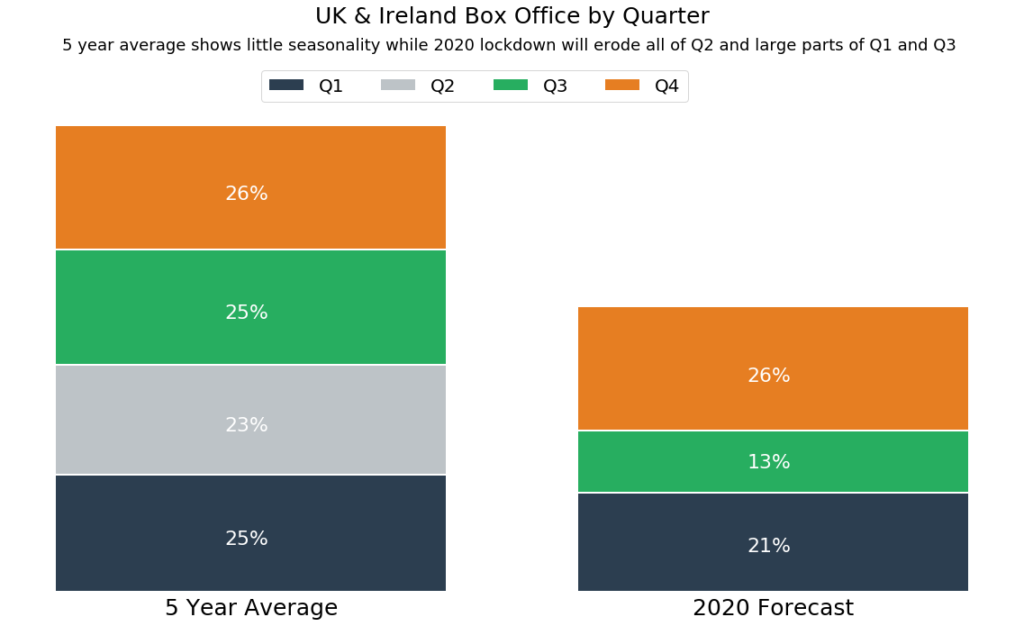The unprecedented impact of COVID-19 on the global box office over the past few months has raised much concern and speculation for the future of our industry. The immediate question for most has been ‘how do we recover?’. As a Film Analytics company, specialising in release date optimisation via our theatrical market simulation tool FORECAST, this question has been the driving force behind our work since the pandemic began.
Gower Street has been tracking global box office loss since the outbreak first began impacting cinema attendance globally. By 05 April less than 1% of cinemas across the globe were reporting box office figures. The majority of territories shut down completely, with no indication of when they would be able to re-open.
We have been using this time to not only track, but also predict what global recovery could look like, and have already published our 5-stage Blueprint To Recovery, identifying the key markers of market recovery. Recovery will differ per territory and is dependent on many factors, such as: capacity restrictions following social distancing measures; economic pressures; audience willingness to return; staggered re-openings across regions/states; differing re-opening plans per exhibitor; and lack of product in the market.
We have used the following steps to analyse how 2020 will compare to the average annual gross box office (based on the last 5 years): how much we have lost from Q1; how much we could lose from Q2; what we can reasonably expect when cinemas reopen; and where the annual box office could end up.
This article explores these steps for the UK & Ireland, but we will also be publishing an article for each of the major territories we curate in FORECAST over the coming days: Domestic; Germany; Mexico; Australia; and Spain.
Forecasting 2020 for the UK & Ireland
In the UK & Ireland, the average annual GBO (£1.35bn) is fairly evenly split across the four quarters, with Q1 representing approx. 25%, Q2 23%, Q3 25%, and Q4 26%.

By 31 March 2020, the UK box office was sitting at 21% of the average annual gross for that quarter due to the downturn in cinema attendance from early March, leading to the complete shutdown from 20 March.
With still no confirmation of cinema re-openings in the UK, and the latest Government guidance indicating 04 July at the earliest, the 23% usually represented by Q2 will be lost (unless Government guidance changes).
For Q3, we looked at all the titles with a lifetime GBO estimate over £1 million still dated (correct as of 27 May) to get a ‘best case scenario’ for this quarter (estimates based on a pre-COVID/fully-operational market). The result of which would mean Q3 representing just over 14% of the average annual GBO.
Assuming Q4 performs as though unaffected and grosses 26%, 2020 would be 39% smaller than the average annual GBO.
To take post-COVID market conditions into account, we then sought to find the ‘best case scenario’ employing social distancing day caps (more information on how we have calculated the caps can be found here). We have worked with 3 different social distancing models: strict (each day capped at £3m); moderate (£5.1m day cap); and relaxed (£7.1m day cap).
The 3 Social Distancing Scenarios
Strict – Assuming that strict social distancing measures were applied every day from cinema re-openings on 04 July – 31 December (every day capped at £3m), and every single day reaching that cap, 2020 would sit 40% behind the average annual GBO. This is based on the £284 million grossed in 2020 so far, plus the maximum remaining that could be achieved.
Moderate – Assuming that strict social distancing measures were applied every day from cinema re-openings on 04 July, then moderate social distancing measures (every day capped at £5.1m) employed from 01 October, with every day reaching those caps, 2020 would sit 25% behind the average annual GBO.
Relaxed – Assuming that strict social distancing measures were applied every day from cinema re-openings on 04 July – 31 August, moderate social distancing applied from 01 September – 31 October, and relaxed social distancing measures (every day capped at £7.1m) applied 01 November – 31 December, with every day reaching those caps, 2020 would sit 22% behind the average annual GBO.
Although we do not anticipate every day from re-opening until the end of the year grossing these day caps, they give us a clear percentage to start from to then incorporate other impacting factors.
Other Factors
As of writing this, only 315 titles are on the calendar for the whole of 2020 compared to the 900+ released each previous year (2015 the exception with 868). Of that, 79 titles are currently dated for Q3 2020 compared to 2019’s Q3, which boasted 216 new releases plus 112 holdover titles from Q2. Q4 2020 currently has 56 titles dated compared to 2019’s 244 releases. With the first half of Q3 the earliest point in recovery, already sporting tentpole titles such as TENET and MULAN, and the latter half having at least one major release per week, our analysis indicates that Q3 2020 is already close to capacity. We anticipate seeing more titles dated in Q4 as confidence in the market grows throughout Q3.
Given this lack of product compared to previous years, as well as the question of audience willingness to return to cinemas, we also needed to calculate a re-opening market percentage that would reflect these differences in the current market to historical years. We calculated this to be between 10-15% of the historical average for the same date.
To get from our re-opening percentage to our end of year (EOY) total we needed to implement a reasonable rate of recovery, that is, the rate at which we think weekly grosses will grow and is effectively a measure of consumers’ willingness to return to the cinema. We believe it will initially be very product-driven but will continue steadily, reaching a return to full confidence by the end of the year. Our Lead Data Scientist, Dr Iain Rodger, has created a model that takes the EOY expected drop, re-opening market percentage, and 5-year average GBO (per week) to calculate the corresponding growth rate.
Working from our ‘best case scenarios’ (we have applied the moderate scenario day caps/time frames) outlined above, then factoring in our re-opening market percentage, recovery rate, and social distancing caps, we have calculated that 2020 ending at 40% behind the UK & Ireland average annual GBO is achievable based on each day hitting its full potential. This would translate into approximately £811 million GBO.
With this recovery model implemented in FORECAST, we are able to predict when we are likely to reach each of the 5 stages of recovery in the UK & Ireland (based on the current calendar and anticipated lockdown end date).
STAGE 1 – 80% (by market share) in operation. Current government guidelines indicate 04 July, though Vue Cinemas are currently the only major Exhibitor to have confirmed they are working to the 04 July date. In Ireland, cinemas are currently not permitted to open until August 10th.
STAGE 2 – box office hitting the lowest day’s box office gross from the past two years. For the UK & Ireland this would mean hitting or surpassing £885k.
We are predicting the 17 July / opening day of TENET being when the UK will hit stage 2.
STAGE 3 – first full week of operation where box office reaches the lowest week’s box office gross from the past two years. For the UK & Ireland, stage 3 would mean grossing at least £12 million in one week. We forecast hitting this marker the week commencing 14 August, which sees WONDER WOMAN 1984, THE ONE AND ONLY IVAN, and THE SECRET GARDEN opening.
STAGE 4 – First full week to achieve a median level of business based on the past 2 years. For the UK & Ireland this would require grossing £25 million or above. We anticipate hitting this stage the w/c 13 November/opening week of NO TIME TO DIE.
STAGE 5 – equivalent performance to those in the top quartile of weekly business from the past two years. For the UK & Ireland this translates to £29 million, which we anticipate hitting (just) at the same time as stage 4 on the w/c 13 November.
Of course, our EOY prediction relies on several changeable factors. We will continue to track and react as cinemas re-open and more information becomes available to us.



